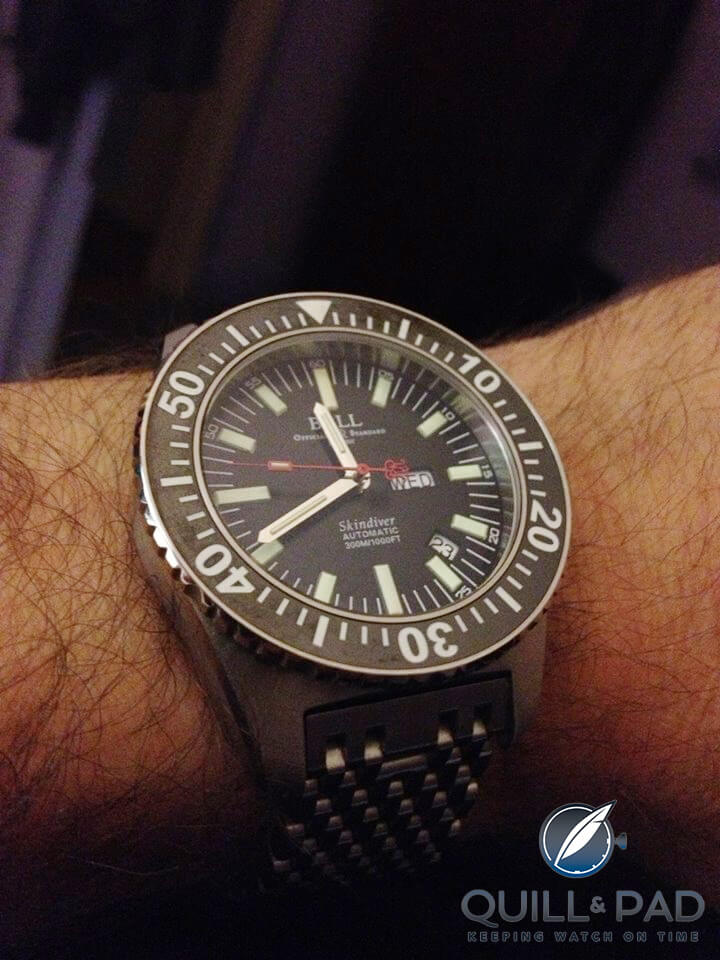Ball Watch SpringLock Shock Protection Tested By Kiss Drummer Eric Singer
In the relatively short amount of time since Ball Watch re-entered the watch world – after having been refounded in the early 2000s, it officially started distributing in the United States in 2004 – the brand has managed to create a few interesting technical details to enhance its interesting, affordable watch range.
Innovations include the extreme luminosity associated with any modern Ball watch, which is created by self-powered micro gas tubes. Another is the company’s research into movement lubricants with great adhesive qualities allowing the watch to remain stable at temperatures between -40°C to +60°C. Anti-magnetism to 12,000 A/m is also a common characteristic of a Ball watch.
As of 2014, Ball Watch’s arsenal of technical improvements also includes the patented SpringLock system.
In a nutshell, the SpringLock, created in-house under the careful guidance of Ball’s chief technology officer Philippe Antille, minimizes distortion of the balance spring due to shocks.
Ball Watch’s extensive testing of the SpringLock system – including on Kiss drummer Eric Singer’s wrist during concert playing conditions – allowed the brand to announce a 66 percent reduction of inaccuracy caused by shocks.
The SpringLock protects the balance spring within a kind of cage that absorbs the energy of an external impact. Ball Watch claims that the 66 percent increase in shock absorption is enough to allow the wearer to freely engage in activities such as golf – and drumming – while wearing the watch.
These are activities known to disrupt timing due to repeated shocks – which can deform the balance spring and even break the regulator.
G forces
Ball Watch has for years sought to increase its watches’ resistance to G forces created by physical impact. Standard resistance in a Ball watch is 5,000 Gs, while the Engineer Hydrocarbon collection is rated up to 7,500 Gs. The watches undergo rigid testing procedures and are subjected to a torque test simulating daily wear.
It is not unheard-of in today’s competitive market to use well-known testimonials and sports figures to test shock resistance under real-time conditions. Richard Mille has repeatedly had his ambassadors do this; the most recent example is the Richard Mille RM 27-02 worn by tennis great Rafael Nadal (read Richard Mille RM 27-02 For Rafael Nadal: The Quintessential Sports Tourbillon for a full breakdown of the G forces the watch experiences on a tennis court). That tourbillon timepiece is certified to withstand 5,000 Gs. Nadal explained to me that his on-court performance would probably not need that great amount of shock resistance.
There have been no studies on G forces created by a rock and roll drummer, but Kiss’ Eric Singer verified in an interview that conventional watches quickly get out of whack when he wears them to drum, even lightly. In fact, as he explained in Eric Singer: Kiss Drummer And Watch Collector, “I wore [another watch] for just one song and it totally messed up the amplitude, it was way off, [the drumming] whacked it right out.”
“Whenever I’ve worn the Ball, I don’t even worry about it because it’s got SpringLock. So I wear that [at times on stage], and I have no problem wearing it, because I know it’s meant for that,” the iconic drummer explained to me during an interview.
To see an excellent analysis of professional drumming’s effect on the body, and in particular the wrists, and what happens when the sticks hit the drums and cymbals please watch this Discovery Channel scientific video featuring Dream Theater’s Mike Mangini.
Eric Singer and Ball Watch
Singer became associated with Ball Watch thanks to a 2009 backstage meeting with U.S. Ball Watch distributor Jeffrey Hess, who worked in concert promotion long ago before turning to his true vocation, watches. Singer perhaps feels a bit connected to Ball Watch since this brand was founded in Cleveland, Ohio, USA by Webster C. Ball. Singer himself was born in Cleveland in 1958.

Drumming is a tough shock test for any watch; here Eric Singer plays on stage with Kiss in Leipzig, Germany
Singer tested the SpringLock-outfitted Ball Engineer Hydrocarbon Airborne during a full concert Kiss played Tokyo in late 2013. Rob Caplan of Topper Jewelers (which carries Ball Watch) wrote extensively on this testing, which you can read here.
For an idea of how hard Singer is on a watch while playing, see Caplan’s video above of Singer playing a drum solo while wearing a Ball watch.
Singer currently often wears the Ball Engineer Master II Skindiver II, which some aficionados have affectionately dubbed “the Eric Singer.” The reason for this is because Singer successfully lobbied Ball’s executives to make the original Skindiver launched in 2011 larger to accommodate fans of the brand who, like the drummer, enjoy its vintage style but would like a larger watch. The Ball Engineer Master II Skindiver II measures 43 mm, while the previous version was 40 mm. The watch does not officially carry his signature.
The SpringLock shock protection system is currently at home in the following Ball models: Engineer Hydrocarbon Airborne, Engineer Hydrocarbon Black, Engineer II Magneto S, and Trainmaster Cannonball II.
For more information on Ball Watch, please visit www.ballwatch.com.
You can discover more about Eric Singer’s extensive and eclectic watch collection at Eric Singer, Kiss Drummer And Watch Collector.
Quick Facts Ball Engineer Master II Skindiver II
Case: stainless steel, 43 mm, ceramic luminous unidirectionally rotating bezel
Movement: automatic Caliber RR1103-C (ETA base), shock-resistant to 5,000 Gs, anti-magnetic to 4,800 A/m, officially C.O.S.C.-certified
Functions: hours, minutes, seconds; day, date
Price: $2,899
Trackbacks & Pingbacks
-
[…] Discover more about the Ball Watch SpringLock by clicking Ball Watch SpringLock Shock Protection Tested By Kiss Drummer Eric Singer. […]
Leave a Reply
Want to join the discussion?Feel free to contribute!








The “on-wrist” photo is a Skindiver I; the Skindiver II does not have a day complication.
Thank you for that. I have updated the caption.
Regards, Ian